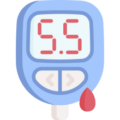Author(s)
KyAnn Wisse, PharmD,BCACP
Dawn Fuke, PharmD, BCPS
Reviewed By
W. Cheng Yuet, PharmD, BCACP
Jennifer N. Clements, PharmD, BCPS, BCACP, CDE
Is self-monitoring of blood glucose (SMBG) cost-effective? There is no question that achieving good glycemic control is one means to decrease diabetes-related complications.1 SMBG is often recommended to help guide treatment decisions. Consumer-oriented advertising often promotes frequent SMBG as means to achieve better glycemic control but current clinical practice guidelines do not provide specific recommendations regarding the frequency of blood glucose monitoring.
The clinical effectiveness of SMBG is unclear, particularly in non-insulin treated patients.2 Several systematic reviews and meta-analyses have shown SMBG at least once daily leads to statistically significant but perhaps not clinically important reductions in hemoglobin A1C (A1C) (0.25-0.35%).2,3 Over $1.3 billion dollars were spent on SMBG testing supplies for US Medicare patients in 2012.4
The lack of conclusive evidence supporting the clinical benefits of routine SMBG combined with the rising costs of healthcare has led some payers to place limits on SMBG testing supplies.5 Proponents of frequent SMBG state that limiting testing supplies would lead to worsened glycemic control and poor health outcomes. But is this really true? With the potential for considerable costs savings, should SMBG supply limits be instituted for patients who do not require insulin therapy?
A study was conducted in Canada to determine the effects of limiting SMBG supplies in patients enrolled in the Ontario public drug program.5 The program is similar to the US Medicare/Medicaid system (eligibility based on age 65 or older or pre-existing social/medical conditions). The Ontario public drug program began limiting SMBG supplies in August 2013. This study was a cross-sectional, population-based, time series analysis evaluating patients with diabetes aged 19 or older who were eligible for public drug program between April 1, 2008-March 31, 2015. Patients were then stratified into four mutually exclusive groups based on therapy the year prior and test strip limitations were determined based on likelihood of hypoglycemia. Those who used insulin were allowed up to 3000 strips per year; those taking oral glycemic control agents known to cause hypoglycemia (e.g., sulfonylureas) were limited to 400 test strips annually, and those prescribed oral glycemic control agents that do not cause hypoglycemia (e.g., metformin, thiazolidinediones), or no medications were limited to 200 test strips annually.
The primary analysis was emergency department (ED) visits for hypoglycemia or hyperglycemia. The secondary outcome assessed A1C change. A sensitivity analysis was performed specifically for high volume users — defined as those who used more than the annual limit of test strips in the year prior to implementation. Given that very few insulin-treated patients exceeded the limit of 3000 annually, this group was excluded from the sensitivity analysis.
During the seven-year study, the number of eligible patients increased by 51% (N = 834, 309) – likely reflecting the increasing prevalence of type 2 diabetes in the population as well as increased enrollment in the Ontario drug program. Eligible patients were a mean of 72.3 years old and slightly more than half (50.4%) were male. Results were presented by age subgroups <65 years and >65 years. A majority of patients were ≥65 years old (84.7%)
The implementation of SMBG test strips limits was associated with a nonsignificant reduction in ED visit rate for both hypoglycemia and hyperglycemia in both age groups (Table 1). When looking at the specific treatment groups, rates of hyperglycemia and hypoglycemia were highest among insulin-treated patients; however, outcomes remained stable over time in all four treatment groups. With regard to mean A1C, no change was observed after implementation of the quantity-limit policy and A1C values remained stable over the entire study period (ranging between 7.4% to 7.7% in those <65 years and 7.0% to 7.2% in those ≥65 years, p=NS).
Table 1: ED visits over study period (2008-2015, policy limitation Aug 2013)
|
|
Age <65 years |
Age >65 years |
||
|
% change |
Visits per 1000 eligible patients |
% change |
Visits per 1000 eligible patients |
|
|
ED visits for hypoglycemia |
-38.8% |
-4.9 to -3.0 (p=NS) |
-55.2% |
-2.9 to -1.3 (p=NS) |
|
ED visits for hyperglycemia |
-14.3% |
-4.2 to -3.6 (p=NS) |
-37.5% |
-0.8 to -0.5 (p=NS) |
NS = non-significant
In the sensitivity analysis of 140,118 high volume users, the rates of hypoglycemia, hyperglycemia, and A1C values were lower than the overall group. However no change was seen after implementation of policy limits.
These results are consistent with recent evidence that failed to show a benefit from frequent SMBG (once daily vs ≥2 daily tests) in terms of improved glycemic (A1c) control.6 Moreover, glycemia-related ED visits were not significantly impacted when SMBG monitoring was less frequent. A strength of this study is utilizing hard outcomes (ED visits for hypoglycemia and hyperglycemia) versus solely surrogate outcomes (e.g., A1C) which have routinely been the primary outcome in past studies. It provides evidence that patients can be safely managed on antihyperglycemic therapies that have a low risk of hypoglycemia without the need for routine glucose monitoring.
While the quality of care does not appear to have been negatively impacted, the SMBG test stip policy limitation led to significant cost savings — a 20% decrease the first year after introduction — from $107 million to $83 million dollars.5 These cost savings were primarily observed in non-insulin treated patients. Therefore, limiting SMBG can result in significant cost savings without increasing risk for patient harm.
There are several limitations to this study. First, it only assessed the impact for a period of 1.5 years after the policy implementation. However, one would expect any negative impact to be seen immediately after implementation of limits as this is when the change would have had the greatest impact on patient behaviors, especially among high volume users. Furthermore, the study did not look at specific sub-populations such as newly diagnosed patients or patients with poorly controlled diabetes (A1c >9%). Nor did the authors perform an analysis based on the type of insulin regimen (once daily basal insulin regimens versus multiple daily dosing regimens). Perhaps more frequent SMBG is beneficial in some subgroups of patients and may lead to improved glycemic control. Future studies are needed to determine whether SMBG limitations affect cardiovascular outcomes or microvascular complications long term.
As an observational claims-based time series study, the investigators could not assess how often clinicians made changes to therapy based on SMBG. SMBG is most useful when the blood glucose values influence changes to pharmacotherapy or lifestyle. There is an ongoing study of non-insulin treated patients with type 2 DM to determine the effect of SMBG with monthly follow-up visits on A1c levels.8 This study may provide further insight into the benefits of SMBG with close follow up.
As costs of healthcare continue to rise by nearly 5% every year,9 it is imperative to find ways to limit spending. Based on this study, limiting SMBG testing supplies while checking A1c levels every 3 to 6 months resulted in significant cost savings without causing patient harm. It may be time to reduce the frequency of home monitoring and focus more on appropriate in-office follow up for treatment modifications. Do you agree? Should we cut costs by limiting SMBG testing supplies in non-insulin treated patients? Is routine testing necessary? Let us know what you think.
- Marathe PH, Gao HX, Close KL. American Diabetes Association Standards of Medical Care in Diabetes 2017. Diabetes Care. 2017; 40 (Supp 1): S48-S56.
- Malanda UCABL, Welschen LM, Riphagen II, Dekker JM, Nijpels G, Bot SD. Self-monitoring of blood glucose in patients with type 2 diabetes mellitus who are not using insulin. Cochrane Database of Systematic Reviews. 2012.
- Farmer AJ, Perera R, Ward A, et al. Meta-analysis of individual patient data in randomized trials of self monitoring of blood glucose in people with non-insulin treated type 2 diabetes. BMJ. 2012;344(1): e486. doi: https://doi.org/10.1136/bmj.e486
- Hahamian J. Blood Glucose Test Strip Utilization Within Medicare. Journal of Diabetes Science and Technology. 2014;8(2):429-430.
- Gomes T, Martins D, Tadrous M, et al. Association of a Blood Glucose Test Strip Quantity-Limit Policy with Patient Outcomes. JAMA Internal Medicine. 2017;177(1):61.
- Young, LA, Busa JB, Weaver MA, et al. Glucose Self-monitoring in Non-Insulin-Treated Patients with Type 2 Diabetes in Primary Care Settings. JAMA Internal Medicine 2017; 177 (7): 920-29.
- Parsons S, Luzio S, Bain S, et al. Self-monitoring of Blood Glucose in Non-insulin Treated Type 2 Diabetes (The SMBG Study): study protocol for a randomized controlled trial. BMC Endocrine Disorders. 2017;17(1): 4.
- Khunti K, Wolden ML, Thorsted BL, Andersen M, Davies MJ. Clinical inertia in people with type 2 diabetes: a retrospective cohort study of more than 80,000 people. Diabetes Care. 2013;36(11):3411-7.
- Peter-Kaiser Health System Tracker website. http://www.healthsystemtracker.org. Accessed 6.15.17






 iForumRx.org is a web-based community of practice designed to inform ambulatory care pharmacy specialists, pharmacy residents, and student pharmacists about high-quality, practice-changing evidence.
iForumRx.org is a web-based community of practice designed to inform ambulatory care pharmacy specialists, pharmacy residents, and student pharmacists about high-quality, practice-changing evidence.
C’mon, you’re smarter than this
Yeah, we should do away with scales because when people use them their weight doesn’t change. Let’s get rid of watches. No matter how often we look at them, time doesn’t change. My point is a simple one. Scales are valuable for heart disease patients as deterioration can be detected by weight change. Watches are valuable when you have a dentist appointment and can’tbe late. It is all about CONTEXT!! When you find a study where people who didn’t test before now test daily or once a week and they don’t get better we are quick to say “SMBG doesn’t work” No, the technology doesn’t lower glucose…it’s what you DO with the information and what the CONTEXT of the information is. I would argue that we should significantly increase the frequency of SMBG! Have patients test before and after breakfast and help them realize which breakfasts have the most effect, then USE that information to. THAT’s where the value is…teaching patients about food. Repeat with lunch and dinner.
continuing
Do you download patient meters? do you ask patients to keep a food diary? do you review SMBG values in light of the diary entries? Do you motivate change? The best study of this type was Schwedes in Diabetes Care in 2002. They did this with type 2 patients. The doctor (they didn’t have really smart pharmacists at the time) reviewed the SMBG results and the diary and asked the patient three questions: What do you see? What do you think caused it? What are you going to DO about it?!! They had the largest decrease of glucose of any study because the practitioner USED the information to help patients come to the realization ON THEIR OWN as to what their problems were and COMMIT to the practitioner what they were going to do in light of that information. Pretty radical stuff, eh?
PS:
The poll at the beginning of this (upper left) shows a clear bias. You can design a better poll as well…try adding a choice of “Test at least twice a day around meals and USE the data to elicit behavior change” 🙂
Yes, SMBG is a tool … but …
Kim – your comments certainly make sense and certainly affirm a widely held belief that monitoring must be good because it might provide useful data. But the same can be said for nearly every lab test that we could perform – it might provide useful data. So, by that reasonings, because it might provide useful data, should we always attempt to obtain the data? If the data isn’t used to make changes (either by patients or clinicians), wouldn’t you agree it’s a waste of time and resources? Is SMBG really the best tool in all circumstances? I think the answer is clearly no. Fitbits haven’t made most of us thinner or happier. It makes sense in some context (as you say) and not others. The data clearly bear this out—many patients with DMT2 who do not use insulin don’t seem to benefit from routine self-monitoring. For me, the bottom line is that we need to be more thoughtful. We (patient and clinician) should make a deliberate decision to engage in SMBG to make specific decisions.
Agree to disagree
No, I don’t believe it is a waste of time and resources. First, the cost is dramatically less since competitive bidding. Second, there is a clear relationship between testing frequent and glucose control. Third, the kind of superficial assessment of the value which you find in many studies discourages the use of the technology per se, when studies of value (Polonsky, ROSSO and several others are NOT promoted as they should be. That later point is OUR fault as preceptors. If all PGY1s were taught how to extract value from SMBG, we would then begin to realize the power of the tool. As The group CSNY said “teach your children well”. Shame on us for not doing so.
Kim
Agreeing in part …
I agree that SMBG data – when collected – should be used. Shame on us if not. For patients unaware of the impact their diet has on BG, it can be a useful tool. For patients on insulin, it is extremely valuable to make dose adjustments. When are actively adjusting meds and determining if post-prandial vs fasting vs both are the problem … very helpful. But what about a patient on metformin whose A1c is 6.5%, who has adopted a healthy diet, lost 20 lbs, and is exercising every day. Should we ask this patient to monitor MORE often? 2+ times a day, as you suggest?Long-term, forever? What decision is going to be impacted by this data? The recently published MONITOR study found that patients who did not monitor did as well as those who 1) monitored daily AND 2) received tailored feedback AND 3) providers received recommended therapy changes based on the data. No impact. Clearly, strip manufacturers want us to test more often. Not suggesting getting rid of SMBG-but not always needed.
SMBG necessary, but not “One-size-fit-all” tool
SMBG should be not be a “one-size-fit-all” tool. It should be patient-centered with patient’s full understanding of the purpose for monitoring, interpretation and application of the results. In agreement with Stuart’s reasoning above, it behooves us (pharmacists) to engage patients in setting realistic, useful SMBG monitoring schedules based on pt. specific factors including but not limited to: medication regimen, A1c and socioeconomic status. I do not agree with daily random testing; before, after each meal, at bedtime and odd times for every patient. The manufacturers will absolutely love that! If we are not doing this already, it is time to customize our SMBG recommendations for each patient. Some patients need a break or a less stringent SMBG regimen.
An Opening for CGM
Targeted, short-term, intensive monitoring of glucose levels with a continuous glucose monitor (CGM) might fulfill Dr. Kelly’s desires while also adhering to a strictly evidence-based approach. Like it or not, the march toward shorter, more superficial office visits is only gaining momentum (even among clinical pharmacists). Expecting frequent SMBG to be adequately evaluated and discussed in these shrinking time windows strikes me as unrealistic. Alternatively, patients can utilize a CGM for a couple days and engage in one extended visit to review the results. In my experience, these visits lead to revelations that would be difficult to replicate across a series of abbreviated office visits.